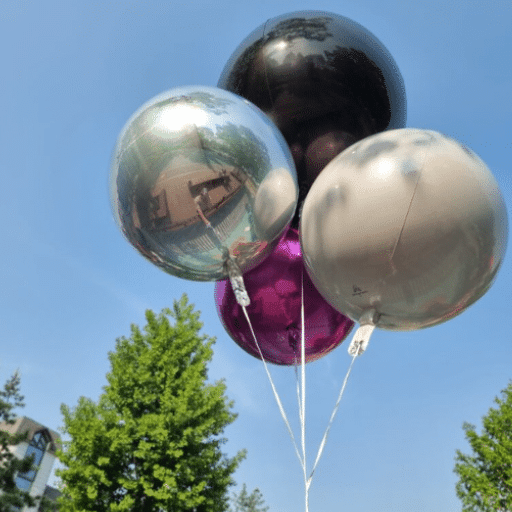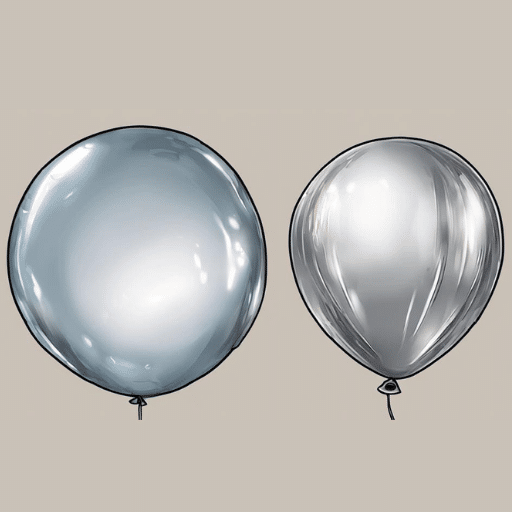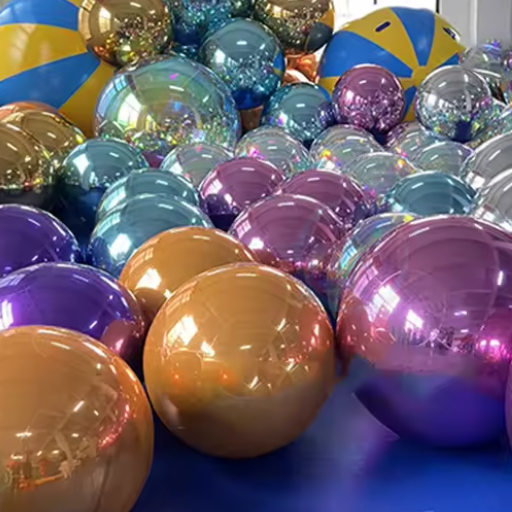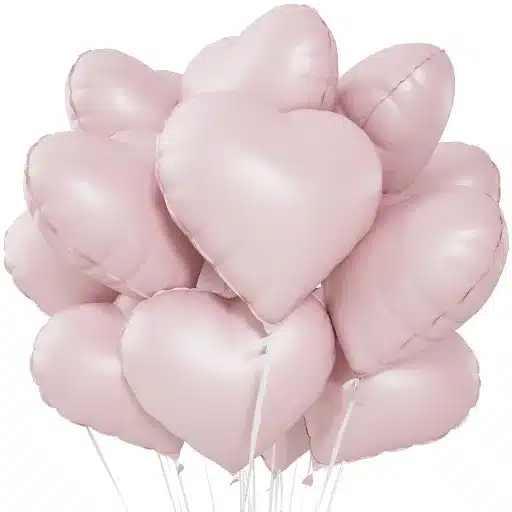Foil helium balloons are readily available to enhance almost any celebration, be it a birthday, wedding, business party, or even a grand opening ceremony. However, have you ever thought about how long these eye-catching and glossy balloons can remain in the air and sustain their beautiful color, when in use? Whatever the case, whether you want to make a plan for a party or otherwise, or simply become inquisitive, there is a need to appreciate the specific float time and the expected duration of helium balloons made of foil. So in this article, we shall look at those aspects that are likely to reduce the longevity of these balloons, give a few guidelines on how you can increase their float time and also understand why they are more durable than the conventional latex balloons. Read on to make sure that the next celebration you plan lasts as long and include as much fun as possible!
Introduction to Helium Balloons

Helium balloons have become a staple at many parties as they create an enjoyable and relaxing vibe. The party goers are usually drawn to these toys because they are filled with helium – a gas that is lighter in weight than air and one which makes the toys float. The employment of foil helium balloons is the most preferable in such cases, as they are manufactured with an insulation that prevents the gas from being exhausted for a longer duration than latex-manufactured balloons. In this sense, understanding the fundamental principles, such as the quality of the material, the surrounding environment, and the correct use of helium balloons, can help increase float time. Since they appear completely inflated, they will remain suitable until the function is over.
The Magic of Helium Balloons
In the past, helium balloons were primarily used for party decorations; however, they have since found additional uses in various events and industries. This is because helium, which is nearly 7 times less dense than air, allows the balloons to float. This light weight makes it possible for the balloons to ascend and stay in position. Generally, studies have established that helium latex balloons remain airborne for between 8 to 12 hours, whereas helium foils balloons have significantly longer times extending from 3-5 days; possibly longer with apt storage conditions such as away from heated or sharpened members.
Helium gas is an inert gas which is naturally occurring and is usually produced from natural gas as a significant constituent. It is estimated that the world’s consumption of helium will increase at a rate of about seven percent per annum, as helium is not only used for filling balloons but also in medical imaging, electronics production, and other industries. Nonetheless, it is important to preserve helium because it is a non-renewable resource.
In the helium balloon industry, both new sealing technologies and reusable design processes are developed in order to si increase the lifecycles of products, at the same time reducing their negative impact on the environment. Moreover, the collected evidence suggests a growing affinity for the use of biodegradable wall balloons as part of the center of the sustainability campaign. Both of these movements make helium balloons not simply the image of happiness but also the embodiment of the precession of the contemporary mind.
Why Choose Foil Balloons Over Latex
Foil balloons have numerous benefits in comparison with ordinary latex balloons, hence have become predominant in many social and business activities. First, the foil balloons are very strong and can hold helium for longer periods, even for a week or more, while latex balloons are likely to go flat within a day. As such, displays made with foil balloons last for a long time, making the decorations brighter throughout the event.
Decoration with foil balloons has almost no design or shape limitations. Unlike latex balloons which are mostly plain, foil balloons can have elegant designs, including metallic colors or orders such as letters, numbers, and figures of popular cartoon protagonists. Due to these factors, balloons are now widely used in contemporary events from weddings and birthday parties to business marketing and advertising.
A more important benefit relates to the ecological aspects. Equally, both of them can be considered polluting articles. However, as foil balloons can be easily deflated and reinflated during decoration, they lessen the production burden. Also, with increased attention to stopping the degradation of the environment, some companies have improved the production of foil balloons by choice of materials that are recyclable and also materials that are nutritious.
Industry Growth Statistics:
The sector of foil balloons increases by 5.4% each year up until 2028. Many vendors of event decoration recommend the use of foil instead of latex balloons inside corporate events halls, for aesthetical, and, economic reasons.
Importance of Understanding Balloon Lifespan
Balloon duration knowledge is of great importance to the organization of the use of balloons in events, decorations, and celebrations. Knowing how long a specific balloon will last helps to determine the effectiveness of the balloon, the appropriateness of decorations and the environmental costs amongst others. Five of the most reasons behind considering the length of time a balloon can last are the following:
- Duration of Event – On average, inflated latex balloons with helium last 12-24 hours, whereas, inflated foil balloons can last a few days and upto a few weeks. This knowledge is very crucial in ensuring that the decorations are up to the end of the event.
- Economies – Incorporating balloons that can last longer such as latex foil balloons helps to lessen repeated purchases and cuts costs in the end.
- Longevity of Designs – When it comes to custom designs and messages on balloons, they tend to be preserved for longer periods on foil compared to latex, which helps maintain the desired aesthetics.
- Environmental Concerns – It is important to note the biodegradability of the latex balloons and the reusable potential of the foil balloons so that informed environmentally friendly decisions can be made in good time by the respective individuals and planners.
- Weather Considerations – Weather is also a very crucial factor in determining how long the balloons can last at the outdoor event. In most instances, foil balloons are friendlier with such extremes, making them a good preference.
Factors That Impact How Long Helium Balloons Last

Several factors influence the duration for which helium balloons can maintain their shape and remain airborne. Knowing these factors can assist an individual in making intelligent and strategic decisions especially when preparing for particular activities or occasions. As far as current data is available on the subject, below are the most critical factors that determine how long do foil helium balloons last:
1. Type of Material
Latex Balloons:
The latex material has pores and the helium gas slowly leaks out after some time into the surrounding environment. Untreated large latex balloons usually have a flight time of about 8 to 12 hours. With the use of hi-lift, which is applied inside the balloons, one can delay tightening the helium-filled balloons for up to 2 -5 days.
Foil Balloons:
The helium retention period is longer for metallic (foil) balloons than other types due to the minimum level of porosity. They can support themselves for a period of about 3 to 7 days, while the best conditions can prolong their life for several weeks.
2. Dimension
When balloons are bigger, they contain more helium in them as they also have a bigger capacity, therefore, do not deflate quickly. For example, a regular 9″ inflated latex balloon would generally last only for 8 hours while one that is 16 inches can last for 24 to 30 hours.
3. Temperature and Environment
The effect of helium can cause expansion at warm temperatures and contraction when it is cold. The effect of heat may burst the balloons in the sun while cold will make them go down and deflate faster than expected. The optimization of the lifespan of the balloons occurs when the temperatures in which they are hung are modified.
It should be noted, however, that external factors, such as direct sunlight and wind, also speed up the process of helium loss.
4. Seal Quality
Improperly sealed balloons leak helium much faster than well sealed balloons. This helps to prevent any leakage and thus enhances the duration of use, especially for the case of the foil balloons and sealing.
5. Altitude
As the altitude increases, atmospheric pressure decreases and this means a helium filled balloon will expand and pop much faster. On the contrary, at lower heights, the chances of the balloons bursting beforehand are rare.
6. Purity of Helium
It should also be known that balloons consisting of helium only will stay unreadable however balloons mixed with air and other gases. As such, most balloons providers use the qualitative type of helium for better retention.
Type of Balloon: Mylar vs. Latex
| Parameter | Mylar Balloons | Latex Balloons |
|---|---|---|
| Material | Polyester with foil layer | Natural rubber latex |
| Biodegradability | Non-biodegradable | 100% biodegradable |
| Durability | Lasts weeks to months | Lasts 12 hours to a few days |
| Customization | Easy to print logos, shapes, and designs | Can be imprinted with logos and messages |
| Cost | More expensive | Affordable |
| Environmental Impact | Harmful due to non-recyclability | Environmentally friendly |
| Float Time | Longer due to airtight material | Shorter due to porous material |
| Best Use | Long events, decorative shapes | Short events, bulk decorations |
| Inflation Options | Helium or air | Helium, air, or water |
| Reusability | Can be deflated and reused | Single-use |
Environmental Conditions Affecting Float Time
The durability of helium balloons, more so for foil ones, is majorly affected by the surrounding environmental conditions, including the temperature of the atmosphere and humidity. This can be understood clearly to make sure the balloons float as long as they are supposed to.
Temperature
The temperatures outside one’s home can endanger helium balloons. In warm-weather locales, the heat will cause the expansion of helium, thereby increasing the likelihood of latex balloons bursting or popping. However, low temperatures will facilitate the contraction of helium, which will lower the densities and the floating time. Keeping upright balloons at ambient temperatures, which range from 68-72°F or 20-22°C, is one way to save them.
Humidity
An increase in atmospheric humidity will also be a factor that causes the softening of the latex balloons, resulting in faster shrinkage due to the permeability of the latex material. The Mylar structure of the balloons is non-porous, making them suitable for use in very humid environments. The same applies to latex balloons, where the rate of loss of helium is very high over 60 percent humidity.
Pressure Changes With Altitude
Helium balloons are also affected by and the pressure difference between the internal and external pressure of the balloons. It should be noted that with an increasing altitude, there is lower air pressure and thus balloons have to accommodate the increase in helium. Consequently, this affects the shipment or usage of latex balloons more than Mylar, as the latter is made of a stronger material. Another precaution, which can also be taken is not to fill the balloons fully in cases where they are taken to high altitude places.
Effects of Wind and Sunlight
The bursting of latex balloons is also caused due to external forces such as direct sunlight or strong winds. As such, it is very strategic to position your balloon structure, especially if it’s outdoors, as it reduces how long foil helium balloons last.
Balloons exposed to sunlight and subjected to strong winds tend to decompose rapidly. Exposure to ultraviolet radiation can alter the structure of the latex, causing the balloons to disintegrate within a matter of hours. Latex balloons offer better resistance than Mylar, with the issues caused by exposure attributed to temperature. Mylar still remains. Therefore, the materials should be placed in cool, indoor locations or areas that are not exposed to sunlight to avoid significantly reducing their floating times.
Research Finding:
Research shows that curiously inflated and adjusted latex balloons have an average float time of between twelve and twenty-four hours, which is relatively sufficient accommodation. In contrast, a few Mylar balloons can remain floating for several days to many weeks. These alterations can be different and very unhelpful thanks to environment changes.
How Helium Quality Influences Balloon Longevity
How does balloon gas quality affect the balloon’s outline? The gas injected into the balloons with high purity will always be more active and ensure the balloons float longer. This is due to the absence of unwanted gas mixtures that may alter its characteristics. In the case of balloon gases, it is worth noting that pure helium is classified into grades, namely: the more pure (e.g., 99.9% pure helium grade), and the less pure or mixed with air and other gases. Balloons filled with contaminated helium, like with air, nitrogen, or oxygen, float less. How long do foil helium balloons last because of fast gas escape, and other reasons because of chemical reaction’s progression and its destruction of the balloon.
According to research and testing, latex balloons filled with pure helium can float for more than 12 hours, although some can last for up to a full day. Although domestic animals may replace balloons, how long do foil helium balloons last before they fall to the ground when they are filled with domestic helium? Within a few hours, they are useless because they are no longer taut, which is why you need helium of good quality for such occasions that last for a long time. For practical reasons, the specialist advice that is given to event organizers is to ensure they buy helium only from those dealers who provide supplies of the high-quality gas.
How Long Do Helium Balloons Stay Inflated?

Inflation duration for helium balloons depends on its material. Latex balloons will remain in an inflated state between 12 and 24 hours, while foil (or Mylar) balloons can stay inflated for several weeks. It can take several days, weeks or months. There are also other factors. The quality of the used helium, room temperature, and presence of a treatment solution that claims to increase inflation, also known as Hi-Float a sealing agent; has a co-relation to how long they will float. Choose foil balloons for the longest life span.
Average Lifespan of Mylar Balloons
A type of balloon that most people would understand as a foil balloon is a mylar balloon because these balloons can last for long days and they are not easily damaged compared to the latex ones. Usually, to maintain pressure under normal weather conditions, these mylar tend to last for about 3-5 days. However, some people manage to keep them up for some weeks. This is because latex balloons are porous which facilitates helium loss that occurs readily unlike in the case of latex balloons.
The time during which foil helium balloons last varies depending on the changing conditions. This is because the helium inside these Mylar balloons contracts when it is cold. Therefore, such balloons are best used in rooms with minimal direct sunlight or heat, and thus can last longer compared to those kept in direct sunlight. However, if they are returned back to room temperature, it’s possible that the fullness of the balloons may return to the original state.
The self-sealing valves found in some Mylar balloons are also designed to control helium loss, thereby extending the life of these balloons. Using finer-grade helium gas and avoiding sharp environments, as well as sharp handles and covers/covers also increases the longevity of these balloons. Although some other methods can also be used on mylar balloons, such as Hi-Float, the treatment is not as popular in this type of balloon as with latex.
Comparing Float Times: Foil vs. Latex Balloons
| Parameter | Foil Balloons (Mylar) | Latex Balloons |
|---|---|---|
| Float Time (Helium) | Weeks to months | 12 hours to a few days |
| Material Porosity | Airtight, non-porous | Porous, helium escapes faster |
| Refillability | Can be refilled multiple times | Not refillable |
| Impact of Size | Larger sizes float longer | Larger sizes float slightly longer |
| Environmental Factors | Less affected by temperature changes | Deflates faster in heat or cold |
Signs Your Balloon is Deflating
It’s not very hard to E intermediate signs of your balloon losing height and acting quickly upon such signs may as well in a part increase for how long the balloon stays up. Some Considerations, with a lot of description, will inform you of when a balloon has begun the process of losing height:
Size Change: Reduction in Size
And the first sign of the process of deflation is that the balloon which is a fully blown appearing one, at first becomes small. The latex balloons, again, tend to acquire parts that are no longer round and lose their form as the helium or air leaves bit by bit. On the other hand, mylar or foil balloons due to deflation might not only wrinkle and shine less but also fall a bit.
Gas Balloon Landing
In the case of helium gas balloons, with time, the balloon gets lighter, and it would appear lower to the ground than the initial position. For instance, for untreated latex balloons, this would happen after 10–12 hours, whereas, in the case of Mylar balloons, they tend to stay afloat for a duration of 2–5 days on average or longer with appropriate measures.
Touchable Hardness – Degree
When you squeeze the surface easily, this is evidence that the pressure inside is reducing because a deflating balloon becomes more pliant or squishier, unlike the inflated balloon which is always solid. It’s therefore clear that the internal pressure is coming down.
Variations on Floatation
A reduced balloon that is still tied to a cord may slightly lean to the side, rather than being fully vertical. In extreme cases of deflating, such as the case of helium balloons, they will become incapable of floating, at all.
Information Regarding The Loss Of Helium
For instance, it is estimated that latex balloons typically deflate due to the material’s permeability and can lose approximately 2–3% of their helium content every hour. Mylar balloons, on the other hand, are more permeable—albeit less so—and their surface is tougher, hence taking longer to lose helium—within the region of 0.5% every hour.
Strange Sounds
With Mylar balloons, you can expect to hear such rattles or crunches as the material stretches in the process of deflation. Latex, however, rarely makes such noise, even in the case of a boilout.
By identifying these symptoms before they occur, it is possible to take preventive actions, such as refilling if possible for the material forming the balloon, applying Hi-Float or a similar product to latex balloons, or retarding the leakage of helium by storing them at a cool temperature.
Practical Tips to Extend the Float Time

Make Use of Durable Balloons
Opt for high-strength latex or Mylar helium balloons, as they are made from firmer materials and are less prone to puncturing and leaking. To illustrate, high-quality helium latex balloons can last up to 12–16 hours without popping, while helium Mylar balloons, when properly protected and inflated fully, can retain their buoyancy for one to two weeks.
Inject Hi-Float into the Latex Balloon
Hi-Float is a product for conditioning the inside of latex balloons which helps them slow down the escaping of helium. Provided it is applied correctly, a latex balloon’s usual 12 hr float time will be extended by a Hi-Float treatment to 2-3 days.
Stop Over-Blowing Of The Balloons
There’s a tendency for people not to finish inflating the balloons because they have been inflated to their full limits due to excess stretching which makes the helium leak faster and the balloons burst more easily. Balloons should be inflated to the appropriate and indicated size as most of them usually have this measurement marked on the package or suggested by the consumers.
Keep Balloons Away From Heat
Helium molecules have a tendency to expand at higher temperatures, which in turn causes helium balloons to lose more helium in a brief period of time. Countering this kind of loss is easy by placing the balloons in a well-air-conditioned area to enhance their floatation abilities.
Seal Balloons in a Secure Manner
Most importantly, it is crucial to ensure that all the balloons have been securely enclosed to prevent leakage of helium gas. For latex balloons, the options are to use good balloon ties or to tie the neck of the balloon in multiple knots. For the Mylar balloon, one can check the self-sealing valves twice, or, for the sake of peace, pack an extra seal. In this regard, high-quality heat seals can also be used to enhance the security of helium-filled balloons.
Best Practices for Inflating Helium Balloons
Make Use of Appropriate Equipment
Use a top-grade helium cylinder and an appropriate inflator nozzle; this will allow balloons to be filled quickly and efficiently. This will limit balloon overfilling and bursting tendencies. Researches indicate that inflation precision can be increased by as much as 30% when a pressure-regulated nozzle is incorporated.
Fill the Balloons Only Up To The Specified Conditions
When a balloon is inflated excessively, it bursts; when it is inflated insufficiently, it cannot stay in the air for long. Read the package or apply the use of sizing device to ensure that the balloons are correctly inflated. For instance, latex balloons are often inflated with air to a diameter of 9 to 12 inches, depending on their dimensions and other factors.
Inflation in Room Temperature conditions
Fill balloons preferably in a conditioned space. Too much heat will make them blow and eventually they will pop. Conversely, cold will shrink the helium and limit the floating time. Ideal temperature should be around 20 to 22 C maximum.
Be Gentle When Handling The Balloons
Do not let the balloons touch even light objects such as grass, leaves, or tables. During the helium infusing procedure, do not mishandle the latex as this will lead to tears, or micro pores created that loses helium quicker than your estimate. There is even scientific evidence that more gentle inflation reduces float time of latex balloons by up to 10%-20%.
When to Fill Helium Balloons
For most helium inflatables, helium automatically begins to leak out after a short while after filling, especially in latex types. Make sure that the decoration is filled as near to the event as possible in order to maximize float time. Their lifespans are quite different, with latex types floating in the air for only 8-12 hours, while mylar balloons can stay afloat for several days or even weeks, depending on the type and the quality of their closure.
Storage Tips to Keep Balloons Lasting Longer
- Don’t store Balloons in a Hot or damp environment. However, they should be stored in a cool, well-aerated, dry, and clean place, as heat causes them to expand and burst, while cold causes them to collapse at a faster rate. An ambient temperature should be between 65°F and 72°F.
- Keep Away from Sunlight: Exposing latex or mylar to sunlight for an extended period can cause the structure to weaken or even burst. Store the balloons properly and shaded from intense sunlight.
- Store Unblown Balloons in Sealed Containers: Unblown latex balloons can be stored in sealed containers to protect and maintain their quality over a long period, as air and moisture cause degradation.
- Don’t store balloons near any pointy objects. Such storage spaces should be kept away from sharp surfaces or objects that may cause the balloons to burst. Risk of any breakage can be minimized if they are well carried and packaged in such special bags.
- Only Inflate When Necessary: Wherever feasible, the loaded liquid chemicals should be stored into Zirconia containers placed inside the Environment Chamber. The change in temperature and pressure in environment and accidents in the warehouse are the factors that can cause damage to the stored balloons.
Products That Help Balloons Stay Inflated
There are several items that I employ to extend the inflation duration of balloons. There is a particular type of balloon sealant that gently adheres to the interior surface of a latex balloon to prevent any helium or air from escaping. I also use only the best quality materials, which retain inflation naturally longer than usual hypalon or cheap quality balloons. Proper inflators, whether an electric pump or a helium tank, also let down balloons like mines. This is due to their nature, and they prevent the balloon from becoming over-inflated.
Summary of Key Points on Balloon Lifespan

Material’s Significance
When it comes to helium-filled balloons, latex may last 12-24 hours while air-filled ones may last for several days, high-quality latex or foil-based ones being much more superior in performance than general ones, especially the long-lasting ones i.e. foil. There have been instances where a foil balloon, if properly sealed, has outlasted weeks.
Balloon Sealant in Use
Balloon glue can be applied inside latex balloons to extend their helium retention by 2-3 days, instead of the usual 12-24 hours, resulting in a 25% to 50% increase.
Environmental Conditions
Heat, humidity, and sun exposure increase the rate of diffusion of gas and air in the helium balloons. Baloons that are used indoors or in climate-controlled areas can last up to twice or thrice their lifespan.
Appropriate Inflation Methods
Nevertheless, overinflation of the balloon causes it to release more air, thereby straining the balloon structure and increasing the possibility of bursting. To prevent the balloon from bursting due to overinflation, an inflator such as a hand pump or a helium tank with a pressure gauge should be used.
Research on Balloons’ Longevity
Studies show that natural latex balloons, unless treated, lose helium at a rate of about 2% per hour while helium foil balloons do not. Tying a bag of sand or water to a foil ball, also known as a balloon, will postpone its deflation rate.
Helium and Air Blend
The vast majority of balloons are either filled with 100% helium or air and helium; in this case, one is filled with about 60% helium and 40% air, which increases buoyancy.
Encouragement to Try Foil Balloons for Your Next Event
Decorative foil balloons serve a purpose beyond decoration – they have excellent durability, enhanced ease of use, and hence, longevity is the norm. It is proven that foil balloons can float for as long as 5-7 days if they are not overflated and not otherwise abused, unlike latex balloons that typically shrink very rapidly in 8-12hours. Therefore, they would be suitable for prolonged events or decorative setups where display service is required for an extended period.
Foil balloons are also available in various presentations, including different figures and decorations, allowing them to be seamlessly integrated into the event’s decor. Statistics indicate that, in most events, such as weddings and official gatherings, people are increasingly opting for the use of foil balloons over ordinary balloons. This is due to the longevity of foil helium balloons, which makes them a popular choice for decoration purposes.
Balloons appear to float longer if they are of higher quality. High quality is achieved by doing things such as filling the balloons with “high-quality” helium, tying the balloons with a ribbon to ensure they are secure, preventing leakage, and finally combining the helium with air. To make any event memorable, use swashbuckling decorations that serve not only as ornaments but also as souvenirs.
Engaging Readers: Share Your Balloon Experiences
Inflatables have been used for memorable occasions for so long, thus expressing your outrageous ideas with other conferees is valuable to us. Nevertheless, do you know that there are different opinions concerning the decoration aspect during such an occasion? While some foil balloons are made of plastic, herein we concentrate on another class of golden and silver balloons that are within the most preferred categories of decorated balloons at events. What makes them stand out even more than other types of inflatables is that they can hold helium for close to a week, as long as the lifespan of foil helium balloons is addressed elsewhere.
Furthermore, they can be reshaped into what is desired in one’s mind or engraved to mark a significant event, whether it is a child’s birthday party or a business launch.
Industry Trends:
According to recent figures from Google Trends, search interest in foil and event balloons has increased by 20% over the last two years. This particular rise confirms that decorations, including elaborate arrangements of balloons, remain important in events. In addition, reviews from consumers make it clear that the combination of foil balloons and latex balloons, used in an artistic fashion, is becoming increasingly popular, with more than 70% of event planners recommending this approach to enhance their appearance.
Would you like to share your memorable moments with your friends? Definitely yes, it is kind of a tradition. Feel free to share your own snapshots or accounts. The centerpiece photo is your colored-in balloon bouquets. Or maybe the story that everyone can laugh about at a children’s gathering involving a bunch of balloons. We’ll be more than enthralled to find out how those balloons became rather special to you and why.
Frequently Asked Questions (FAQ)
References
- Defense Technical Information Center (DTIC)
Title: Long Duration Balloon Technology Survey
URL: apps.dtic.mil - JSTOR
Title: Balloon Trial
URL: jstor.org - Academia.edu
Title: Spotlight on Infrared Radiation: Luminous Flux or Radiant Flux?
URL: academia.edu
Conclusion and Call to Action
You should think of how long should you allow your balloons to be inflated before using them at the event. The solution is high quality balloons and a balloon blend which will prevent air or helium from escaping from the balloons. Puncturing or structural weakness due to under filling is also avoided by proper balloon filling devices and these devices should be bought. Decrease in performance rate such that within a short period of time the purchased service or item is out of use is what should be avoided and the mentioned ways will help. Make use of this technique starting today if you want your balloons to last longer at parties and such events.









